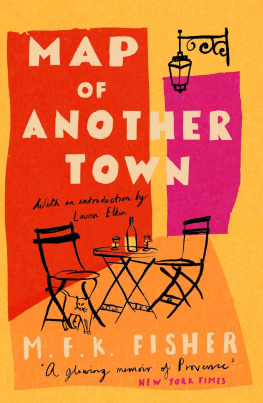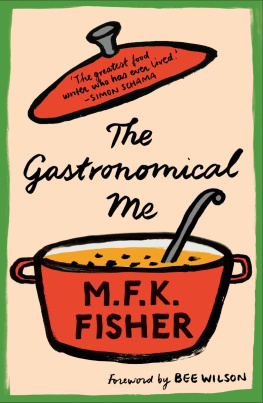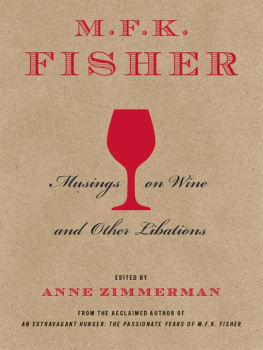A glowing memoir of Provence. New York Times
She is not just a great food writer. She is a great writer, full stop. Rachel Cooke, Observer
A splendid and lovable book. The Times
Poet of the appetites. John Updike
The most re-readable of all prose stylists. Bee Wilson
W.H. Auden said that he did not know of anyone in the US who wrote better prose. John Updike called her a poet of the appetites. In a series of now-classic books on food Serve it Forth (1937), Consider the Oyster (1941), How to Cook a Wolf (1942), and The Gastronomical Me (1943) Mary Frances Kennedy Fisher (19081992) established herself as not only a prominent food writer, but a dazzling stylist. Legend has it she never edited her work; everything we read is meant to be the first and only draft, much like Mozart, taking dictation from God.
In Map of Another Town, her essays on Aix-en-Provence, originally published in 1964, Fisher demonstrates that her powers extend far beyond the realm of the culinary, bringing her gift for evoking taste and texture to the city she loved best in the world, where she lived for several years between 1954 and 1961. Theres no vista, fountain, or curlicue that escapes her enthusiasm; she lovingly documents every caryatid, every statue, every stone turtle in the city of fountains and music.
She devotes entire chapters to doctors, servants, beggars, the pre-Lent fte of carnaval, the effects of Provenal roads on American feet, theatre (housed, surprisingly, in the old royal tennis hall), a boy who haunted her in Lucerne and Aix, the fascinating couple across the way she watches from her window as they fight, eat, clean, and make love, a law professor who killed his wife by getting her pregnant twelve times, at whom his students hiss Assssasssin, asssasssssin It even gets slightly racy in places; the word panties appears far more often than youd think.
If Fishers food writing makes you want to eat, preferably with her, Map of Another Town will make you long to book a budget flight, so you too may stroll down the Cours Mirabeau, mingling with law students and booksellers and newspaper vendors and officious older ladies with their dogs. First stop: Fishers favorite caf, the Deux Garons, or 2Gs as its known locally, for a noontime pastis in the sun. Then over to the Glacier, where Fisher ate lunch every day with her daughters, feasting on ham sandwiches a slender slit loaf of bread spread with sweet butter and curtained limply with ham although her daughter Anne, petite voluptueuse, sometimes skipped the sandwich and lunched instead on a silver bowl of crme Chantilly. To be followed with a romp in a meadow, gathering fresh herbs to fill a sachet, stick in a vase, or liberally strew in ones bath, as Fisher does on one of her return visits to Aix.
Among the Aixois, Fisher reports feeling more alive [] than I was anyplace else in my known world. But Fishers life in Aix was not a dappled succession of gorgeous meals and charming encounters with the locals; there is something darker at work in this book. Although she lived in Dijon as a young bride, from 1928 to 1932, 1954 sees her unmarried in Europe for the first time, a single mother with two girls in her care, no longer young and confident but older, and battle-scarred in a country still reeling from the Second World War. Boarding with a succession of landladies, her daughters living separately at a pensionnat, accentuates this feeling of uncertainty and discomfort. They dont know what to make of her shes too old to be a student, and clearly not a professor; who is this tall American, they wonder? This sense of uncertainty pervades the text, as Fisher describes feeling largely invisible, like a ghost.
The forced intimacy with the Aixois throws into relief her differences from them. To her, they are members of an old, exhausted culture, taking an apparently voluptuous pleasure in exhausting themselves with archaic ceremonies which taxed them almost past remedy. Their snobbishness appals her, and she can be most cutting in return; at the home of one grande dame, The sunlight poured in through the beautiful windows, and stripped Madames face like a scalpel, seeing viciously into the essence of her, the skin within the skin.
She is keenly aware that the grandes dames consider her an outlander, an emissary from a graceless, culture-less people. At dinner, Madame Lanes (often clad in a finger-length cape of thick, long monkey-fur which her husband had given her in Monaco in 1913) would shriek down the table at me with a comradely twinkle, asking how an American could fancy herself an expert on gastronomy, when in the land of her birth from everything we hear, gastronomy does not yet exist? Fisher spends much of the book on a charm offensive, wearing away at the old ladies prejudices.
In post-war France, money was tight and luxuries were scarce. Behind the multi-course meals, Fisher reminds us of the dismal scullery kitchen with its inadequate dribble of cold water and its diminishing stock of chinaware, and its desperately thin larder. I knew of the frantic scribblings and figurings for each days market list, and of the hurried scurryings through the town to find beans or even bread a few cents cheaper. I knew that the wine in the fine glasses was watered to its limit. Then, alarmingly: I knew that the current slaveys eyes were swollen because the cook had hit her for having an epileptic seizure between the third and fourth laborious courses.
Ten years after the Liberation, Fisher notes, French people were still steadying themselves. There are brand-new plaques on street walls commemorating the sites where people were shot down, and the city is full of refugees whose origins are unknown. Many of the people Fisher encounters in the city have been maimed, deformed, or diseased by the war; a housemaid at Madame Lanes is run over by a truck while cycling and this fate is also attributed to the war: Her weak eyes were blamed on the hardships of her refugee childhood, and the motorists were dismissed as men whose driving undoubtedly had been influenced by the liberating Yanks and Tommies in 45. Another maid, Madame says, was badly tampered with when she was a child during the Occupation, and she stopped growing. Now and then she comes alive, and remembers, and it is terrible. A neighbours back had been broken in a labour camp, and her kidneys destroyed. Fisher notes and watches them all, in their daily quiet evasion of disaster.
In the years leading up to the move to Aix, Fisher herself had been through a difficult time, with the illness and suicide of her second husband, her beloved Tim Parrish (Chexbres in her writings) in 1941, and, a year later, the suicide of her brother. Both of her parents died in the late 40s and early 50s. She does not refer explicitly to these events, but references them obliquely, to account for her sensitivity to the psychic and physical scars of the Aixois: All this intimacy with the raw wounds of war was doubly intense with me, perhaps, because I was alone, and middle-aged, and scarred from my own battles since I had lived in France.
Although Fisher is a thoughtful, self-questioning guide, some of her attitudes to race, class and ability are noticeably of their time. For all her open-mindedness (and she recounts regularly giving money to beggars and being markedly kind to housemaids), her outlook is often shaped by the predominant discriminations of her era.
The Algerian War, which began in 1954 and ended in 1962, coincided with the entirety of Fishers time in Aix. Fisher doesnt devote much space to the war, referring only, vaguely, to the Insurrection. On April 22, 1961, as De Gaulles peace negotiations with the FLN were failing, four retired generals staged a








